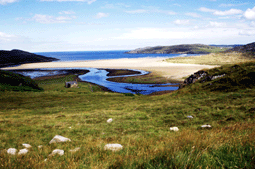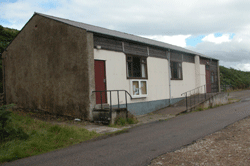
Mackay Country
Dùthaich Mhic Aoidh
An area in North-West Scotland of natural unspoiled beauty, rich in heritage & history
Skerray
Skerray is a small crofting community on the north coast of Sutherland. It lies at the heart of the ‘Land of Clan Mackay’ and occupies a rocky promontory between Tongue in the west and Bettyhill to the east. The name ‘Skerray’ means, literally, “between the rocks and the sea”.
Skerray lies on the minor road set on the bend of a large horse-shoe shaped road that meanders along through stunning scenery and that loops round and joins the A836 again. Though Skerray is all single tract and the many little off shoots of the road leading to the several small townships that make up the whole are easily mistaken for farm tracks. If Skerray is encountered on the passage into Mackay Country then a finer introduction to the land and its people could not be encountered. Like all the Mackay Country it must not be hurried or superficially scrutinized for a true and memorable memory to reflect upon. The passage though the loop to Skerray should be savoured. The area serves as a microcosm both in landscape and personality to the larger area of Mackay Country. A fertile sheltered area locked amongst the grandeur with people of character and integrity with a solid moral fiber.



There are 11 townships scattered across the windswept moors and cliffs: Torrisdale, Achtoty, Lotts, Clashaidy, Clashlevan, Achnabat, Clashbuie, Modsary, Lamigo, Stathanbeg, Strathan, and the deserted village of Slettel. There are two important offshore islands, Island Neave The Priest’s Island close to Skerray Harbour, and, one mile from the harbour, Island Roan, inhabited until December 1938.
There is also an artist’s studio, community workshop, and a busy garden centre that features the unique chrysanthemum ‘Highland White Dream’. While the historical society busily reinforces the times gone by with chronicles, archives and records and plans to convert the old church this little settlement continues to maintain and live old traditions. The museum is part of the Jimsons complex in Skerray. It was opened in 1996 and now attracts over a thousand visitors a year. It contains records and Photographs about life in Skerray and the surrounding area. Many visitors use the museum to research genealogy and enjoy delving into the archives.

Skerray, a crofting township with a pier and sandy bay looking towards the islands of Roan and Eilean Co’omb is a spread out community of about 83 of a population, an active and vibrant group of people with a careful understanding of the needs and a gentle determination to approach the future with a positive attitude. Correctly, Skerray is just one of a number of small townships between Strathan Skerray and the Borgie River but the name is commonly used to describe the whole of this area.

Peat stacks sit at the side of the road and the old mingles with the new designed tastefully to look old. A place where the past and the present meet somewhere in the forgotten present and with the future in clear view. The old ruined church and cemetery still used today at the foot of the brae to Aird must have stories to tell.
The village hall that has seen and still sees a multitude of events and is constantly in use brings the scattered population of Skerray with diverse interests in the arts together for concerts, shows and performances of all kinds. . The Skerray Village Hall is a small unspectacular building but it is renowned for its diversity of world-class entertainment many entertainers have played here and people come from all over to see them
Skerray is a vibrant, forward-looking community. In recent years local enthusiasm has engendered the renovation of ruined croft buildings and these now provide a focal point for both resident and visitor alike. There is a community office with fax, photocopier and computer. Next door, Jimson’s shop (and the Post Office) has become famous for the high quality and diversity of the products it offers for sale.An adjacent building is home and museum to the Skerray Historical Association. The Association mounts an annual exhibition that attracts upwards of 1,000 visitors each year.

“The grass is green
The hills are brown
But most of all I love
My sheep”

